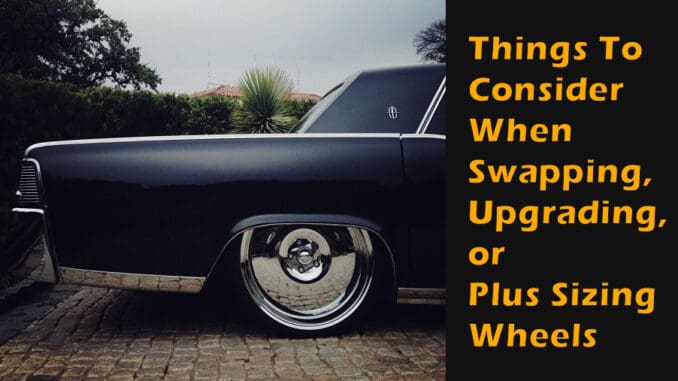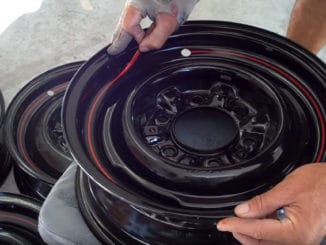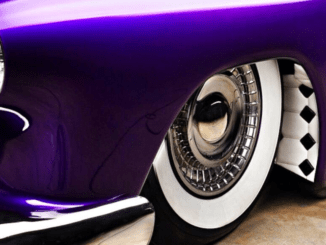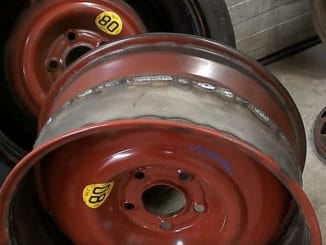
When it comes to wheel upgrades, you’re in good company. There are a lot of motorists who plus-size their wheels for aesthetics. Others look to wheel upgrades for functional purposes — mudding, for example, can be easier with larger wheels.
But before you upgrade your wheels, there’s a lot to think about. We’re going to go over some of the basics that you should consider — that way when you’re in your garage or at the shop for an upgrade, you’ll know exactly what to look for.
Think about your tires
When you upgrade your wheels, you’ll need new tires as they are, of course, made to fit certain wheel sizes. But things can get a bit tricky with tire upgrades.
Plus-sizing your wheels will increase their diameter. That causes a bit of a problem because if the diameter of your wheel is bigger, it will work differently. For starters, your odometer will no longer be accurate, as it uses the number of wheel rotations to calculate how far you’ve traveled.
More importantly, your speedometer will no longer be accurate either, as it also uses wheel rotations to measure speed. That means you might end up traveling 8-10% faster than what your speedometer is telling you – and that can cause huge problems.
There are other issues that can crop up, too. When your wheel’s diameter is too big, parts can end up rubbing up against other parts — and that’s never a good thing.
So what’s the solution? It’s actually pretty simple – reduce the size of the sidewall of your tire. By reducing the height of your sidewall by 1 inch, you keep the diameter of the overall wheel the same!
You’ll want to be careful, though. While shorter sidewalls can improve grip, they can also lead to your vehicle being more prone to hydroplaning and increase the chance of vehicle damage.
Getting the right fit
We’ll tell you in advance — this section basically amounts to: If you’re unsure, find a professional to help you choose the right wheels for your vehicle. You can skip ahead if you don’t want to read about why that’s so important.
And make no mistake, it is important. First, the bolt pattern on your vehicle must be the same as the bolt pattern on the wheel you’re purchasing. You can do some research online to figure this out on your own, but don’t go simply based on how the wheel’s bolt pattern looks when deciding. Unsure of your vehicle’s bolt pattern or want to get a better idea of which OEM wheels will fit? Use our wheel bolt pattern cross-reference page.
Next, you have to consider offset. A positive offset means that your wheel will sit closer to the inside of your vehicle, which reduces the distance between it and your vehicle’s suspension. A negative offset means the wheel will be closer to the outer edge of your vehicle which can lead to a fender rub.
Many motorists choose a negative offset intentionally because it lets them show off their new wheels. That’s an option — just be careful that the offset isn’t so large that you end up damaging your vehicle. Having no offset at all is also an option.
You want to get a professional to help you because they’ll know the exact offset that’s appropriate for the wheel you’re looking for and your vehicle.
Buying a high-quality wheel
There are all kinds of custom wheels and rims available on the market. Generally, alloy wheels are preferable to steel wheels – they come in a wider variety of colors and shapes, and they tend to offer better performance. The only downside to alloy wheels is that they offer less durability than their steel counterparts.
You should be cautious about where you get your wheels from. After-market wheels from a reputable business won’t cause you any problems. Second-hand wheels you bought on Craigslist, on the other hand? Be certain to check for cracks or unusual wear.
Do your research
You’re reading this article, so you’re already well on your way. By thinking about which wheels can fit on your vehicle, how big you want them to be, how the tire will affect the diameter, and what materials the wheel will be made out of, you’re giving yourself a leg up when it comes to choosing the right wheel.
We wish you the best of luck on your search for the perfect wheel — your vehicle will be looking better than ever in no time!




